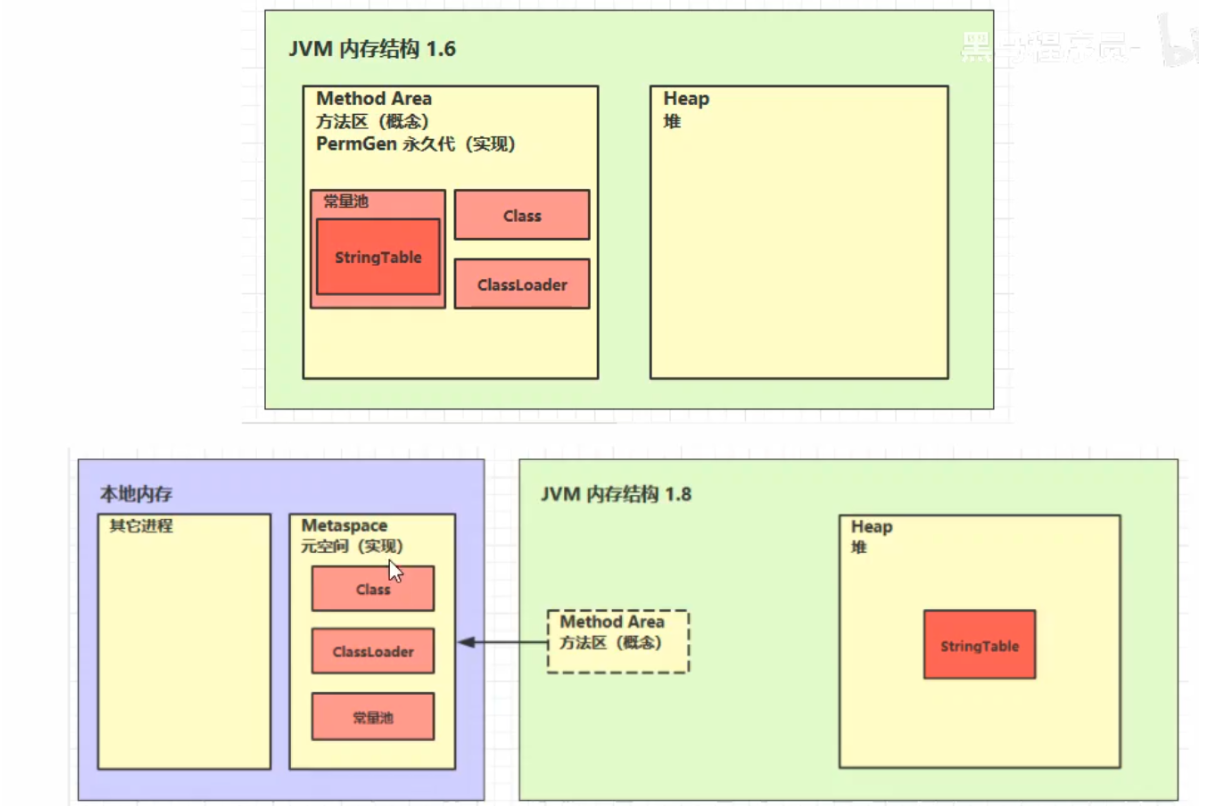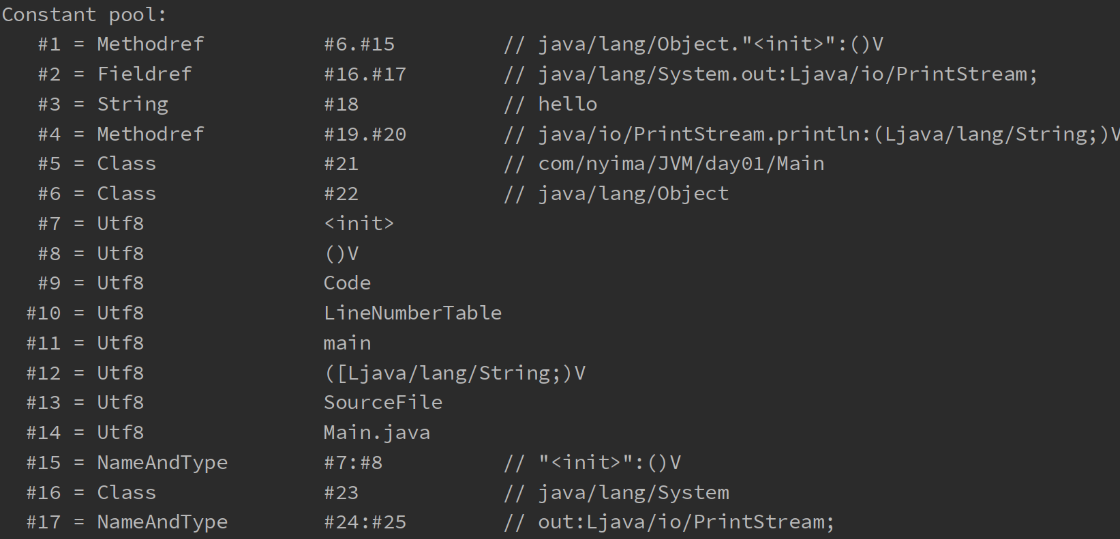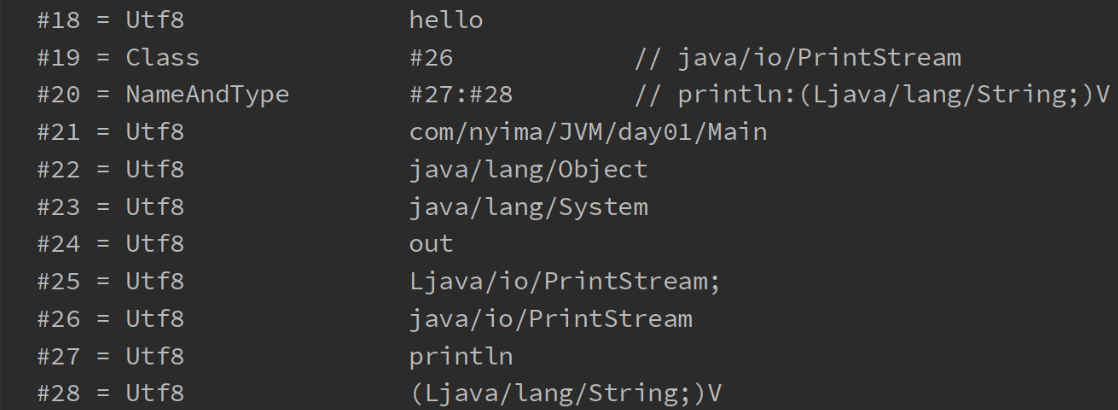Deep understanding of JVM (2) -- memory structure (2)
4. Pile
definition
Objects created with the new keyword are placed in heap memory
characteristic
- The safety of all threads in the heap needs to be considered
- There is a garbage collection mechanism
Heap memory overflow
java.lang.OutofMemoryError : java heap space. Heap memory overflow
Heap memory diagnostics
jps
jmap
jconsole
jvirsalvm
5. Method area
structure
out of memory
- Before 1.8, it will cause permanent generation memory overflow
- After 1.8, it will cause meta space memory overflow
Constant pool
Composition of binary bytecode: basic information of class, constant pool, method definition of class (including virtual machine instructions)
Decompile to view class information
-
Get the of the corresponding class Class file
-
Enter the absolute path of the javap -v class in the console
javap -v F:\Thread_study\src\com\nyima\JVM\day01\Main.class
-
Then you can see the information of the decompiled class on the console
Runtime Constant Pool
- Constant pool
- It is a table (such as constant pool in the figure above). The virtual machine instruction finds the class name, method name, parameter type and literal information to be executed according to this constant table
- Runtime Constant Pool
- Constant pool is * In the class file, when the class is loaded, its constant pool information will be put into the runtime constant pool, and the symbolic address in it will be changed into the real address
Relationship between constant pool and string pool
String pool StringTable
features
- Strings in the constant pool are only symbols and will not be converted to objects until they are used
- The string pool mechanism is used to avoid repeated creation of string objects
- The principle of string variable splicing is StringBuilder
- The principle of string constant splicing is compiler optimization
- You can use the intern method to actively put string objects that are not in the string pool into the string pool
- Note: both strings in the string pool and in the heap are objects
Used to put string objects, and the elements in them are not repeated
public class StringTableStudy {
public static void main(String[] args) {
String a = "a";
String b = "b";
String ab = "ab";
}
}
The information in the constant pool will be loaded into the runtime constant pool, but this is a b ab, which is only the symbol in the constant pool and has not become a java string
0: ldc #2 // String a 2: astore_1 3: ldc #3 // String b 5: astore_2 6: ldc #4 // String ab 8: astore_3 9: return
When ldc #2 is executed, the symbol a will be changed into a "a" string object and put into the string pool (hashtable structure cannot be expanded)
When ldc #3 is executed, the symbol b will be changed into a "b" string object and put into the string pool
When ldc #4 is executed, the symbol AB will be changed into an "ab" string object and put into the string pool
Final StringTable ["a", "b", "ab"]
Note: the creation of string objects is lazy. The string will be created and put into the string pool only when it runs to that line of string and does not exist in the string pool (such as ldc #2).
The process of creating a string using a concatenated string variable object
public class StringTableStudy {
public static void main(String[] args) {
String a = "a";
String b = "b";
String ab = "ab";
//Splice string objects to create new strings
String ab2 = a+b;
}
}
Decompiled results
Code:
stack=2, locals=5, args_size=1
0: ldc #2 // String a
2: astore_1
3: ldc #3 // String b
5: astore_2
6: ldc #4 // String ab
8: astore_3
9: new #5 // class java/lang/StringBuilder
12: dup
13: invokespecial #6 // Method java/lang/StringBuilder."<init>":()V
16: aload_1
17: invokevirtual #7 // Method java/lang/StringBuilder.append:(Ljava/lang/String
;)Ljava/lang/StringBuilder;
20: aload_2
21: invokevirtual #7 // Method java/lang/StringBuilder.append:(Ljava/lang/String
;)Ljava/lang/StringBuilder;
24: invokevirtual #8 // Method java/lang/StringBuilder.toString:()Ljava/lang/Str
ing;
27: astore 4
29: return
The process of creating strings by splicing is: stringbuilder() append(“a”). append(“b”). toString()
The return value of the last toString method is a new string, but the value of the string is consistent with the spliced string, but there are two different strings, one in the string pool and the other in the heap memory
String ab = "ab"; String ab2 = a+b; //The result is false because ab exists in the string pool and ab2 is an object returned by the toString method of StringBuffer and exists in heap memory System.out.println(ab == ab2);
Creates a string using the method of splicing string constant objects
public class StringTableStudy {
public static void main(String[] args) {
String a = "a";
String b = "b";
String ab = "ab";
String ab2 = a+b;
//Create a string using the method of splicing strings
String ab3 = "a" + "b";
}
}
Decompiled results
Code:
stack=2, locals=6, args_size=1
0: ldc #2 // String a
2: astore_1
3: ldc #3 // String b
5: astore_2
6: ldc #4 // String ab
8: astore_3
9: new #5 // class java/lang/StringBuilder
12: dup
13: invokespecial #6 // Method java/lang/StringBuilder."<init>":()V
16: aload_1
17: invokevirtual #7 // Method java/lang/StringBuilder.append:(Ljava/lang/String
;)Ljava/lang/StringBuilder;
20: aload_2
21: invokevirtual #7 // Method java/lang/StringBuilder.append:(Ljava/lang/String
;)Ljava/lang/StringBuilder;
24: invokevirtual #8 // Method java/lang/StringBuilder.toString:()Ljava/lang/Str
ing;
27: astore 4
//ab3 gets strings directly from the string pool during initialization
29: ldc #4 // String ab
31: astore 5
33: return
- When using the method of splicing string constants to create a new string, because the content is a constant, javac will be optimized during compilation. The result has been determined as AB during compilation, and "ab" has been put into the string pool when creating AB, so ab3 directly obtains the value from the string pool, so the operation is the same as ab = "ab".
- When you use the method of splicing string variables to create a new string, because the content is a variable, its value can only be determined at run time, so you need to use StringBuilder to create it
intern method 1.8
Calling the intern method of the string object will try to put the string object into the string pool
- If the string object does not exist in the string pool, it is put successfully
- If there is this string object, it fails to be put in
The string object in the string pool will be returned no matter whether the insertion is successful or not
Note: if the intern method is called successfully at this time, the heap memory and the string object in the string pool are the same object; If it fails, it is not the same object
Example 1
public class Main {
public static void main(String[] args) {
//"A" and "B" are put into the string pool, and str exists in heap memory
String str = new String("a") + new String("b");
//Call the intern method of str. if there is no "ab" in the string pool, the string object will be put into the string pool. At this time, the heap memory and "ab" in the string pool are the same object
String st2 = str.intern();
//Assign a value to str3, because there is "ab" in the string pool at this time, the contents in the string pool will be returned directly
String str3 = "ab";
//Because the heap memory and "ab" in the string pool are the same object, the following two statements Print true
System.out.println(str == st2);
System.out.println(str == str3);
}
}
Example 2
public class Main {
public static void main(String[] args) {
//The string object "ab" is created here. Because there is no "ab" in the string pool, it is put into the string pool
String str3 = "ab";
//"A" and "B" are put into the string pool, and str exists in heap memory
String str = new String("a") + new String("b");
//At this time, because "ab" already exists in the string pool when creating str3, putting in fails, but "ab" in the string pool will be returned
String str2 = str.intern();
//false
System.out.println(str == str2);
//false
System.out.println(str == str3);
//true
System.out.println(str2 == str3);
}
}
intern method 1.6
Calling the intern method of the string object will try to put the string object into the string pool
- If there is no string object in the string pool, a copy of the string object will be copied and put into the string pool
- If there is this string object, it fails to be put in
The string object in the string pool will be returned no matter whether the insertion is successful or not
Note: at this time, the string object in the string pool and the string object in the heap memory are not the same object regardless of whether the intern method is called successfully or not
StringTable garbage collection
When the memory of StringTable is tight, garbage collection will occur
StringTable tuning
-
Because StringTable is implemented by HashTable, the number of HashTable buckets can be appropriately increased to reduce the time required for strings to be put into the string pool
-XX:StringTableSize=xxxx
-
Consider whether you need to pool string objects
You can use the intern method to reduce repeated pooling





